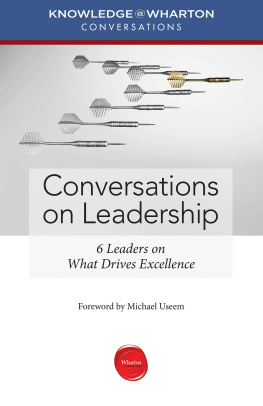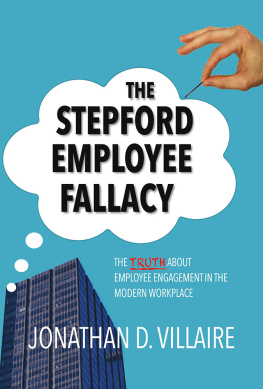Insights and inspiration business leaders can use todayfrom The Wharton Schools online journal of business analysis
If you enjoy this Knowledge@Wharton ebook, build a library of Knowledge@Wharton Books that can help you generate fresh knowledge and new ideas.
Knowledge@Wharton Books offer you the signature reporting that Knowledge@Wharton readers have come to expect in a new and exciting format, including in-depth coverage and analysis of important business trends and accessible explanations of the latest business research.
For more information, please visit KnowledgeatWharton.com/Books .
Foreword
PERHAPS IT STARTS with the loss of one key person who is not replaced. The team members who remain need to pick up their former colleagues responsibilities, adding them to an already full set of commitments. Each person begins to feel more and more stressed. One person complains to another, and dissatisfaction begins to grow. Before you know it, more people leave or begin to withdraw from the organization, and productivity suffers.
While the specific circumstances certainly vary, Knowledge@Wharton reports that this is not an exceptional case: In a 2014 study, 8 in 10 people reported being stressed out by work, and more than half reported being disengaged from their jobs. Another study indicated that more than three-quarters would leave their current workplace if the right opportunity came along.
This important collection of Knowledge@Whartons most popular reporting on the challenges employers face engaging employees examines the reason for the high levels of stress and disengagement, and explores what employers can do to reengage their workforce. Under Pressure: Managing Stress and Engagement on the Job reports on the ways that employers are managing these concerns, from offering perks, to changing the feel of the workplace, to helping employees to gain more work-life balance.
My own research, which is covered in this collection, reveals that emotions, both positive and negative, spread among your employees like viruses. People routinely catch each others feelings when working together in groups. That explains why declining employee loyalty and dissatisfaction can spread so quickly. This phenomenon is known as emotional contagion, and it has long been recognized in the psychological literature as a type of interpersonal influence. But therein also we also find one of the solutions: Positive emotions are just as catching. Fostering a culture of companionate love, where employees showing affection, caring and compassion toward each other can go a long way toward creating a more positive and productive working environment.
Armed with an awareness of emotional contagion, you have the potential to create more productive teams, departments, and corporate cultures. When you choose to acknowledge the problem in your organization and really care about the people who work within it, it is possible to create change within your organization. Picking up this ebook is a key first step.
Under Pressure is filled with insights from leading researchers as well as those of the companies that are on the frontlines of engaging employees. Under Pressure provides key takeaways that you can take back to your organization to reengage your workforce. It is a must-read for any leader who seeks a better working environment for themselves and their team.
Sigal Barsade
April 2015
Introduction
JOB STRESS IS not new, but as we have reported in Knowledge@Wharton, global competition, downsizing, and the state of being constantly tethered to the office by technology have intensified the pressures.
Under Pressure: Managing Stress and Engagement on the Job explores the challenges affecting workers and examines how some companies are addressing these issues to reengage employees. Drawn from the best of Knowledge@Whartons reporting, this volume in the Knowledge@Wharton Essentials series features stories addressing:
- What is causing unprecedented levels of stress on the job
- Why employee loyalty is a casualty of the new workplace
- What perks companies offer and what employees want
- How the 40-hour work week is being redefined
- The challenge to turn off the switch and take a break from technology
- The art of motivating employees
- Why fostering a culture of companionate love in the workplace matters
This quick read features Knowledge@Whartons reporting on the research and thought leadership of Iwan Barankay, Sigal Barsade, Janice R. Bellace, Matthew Bidwell, Peter Cappelli, Adam Cobb, Stewart Friedman, Adam Grant, Wayne Guay, Carolyn Marvin, Olivia Mandy ONeill, JP Pawliw-Fry, Nancy Rothbard, Deborah Small, and Hendrie Weisinger, among others.
Under Pressure is a must-read for those who are experiencing stress on the job due to increased demands at work and at home, as well as employers who wish to understand those who report to them and who are looking for new ways to engage employees.
We hope you gain actionable insights on employee engagement from this ebook. Please send us your feedback at .
The Knowledge@Wharton Editors
Unprecedented Levels of Stress on the Job
IF YOU HAD ASKED any worker since the Industrial Revolution whether he or she was experiencing stress on the job, the answer would likely have been in the affirmativeand emphatic. But workplace experts say something unusual is going on today. Global competition, downsizing and the constant state of being electronically tethered to the office are combining to create a perhaps unprecedented level of stress.
Absolutely, there is no question about that, says Wharton practice professor of management Stewart Friedman, director of the Wharton Work/Life Integration Project. If you look at the span of the last 50 years, we know people are working more, that more of their waking attention is devoted to work and work-related decisions, and its a challenge because the ubiquity of technology has enabled 24/7 communication. For most of us, we didnt grow up with these tools and are still adjusting to what it means to create meaningful boundaries between work and the other places in our life, so thats a new skill.











